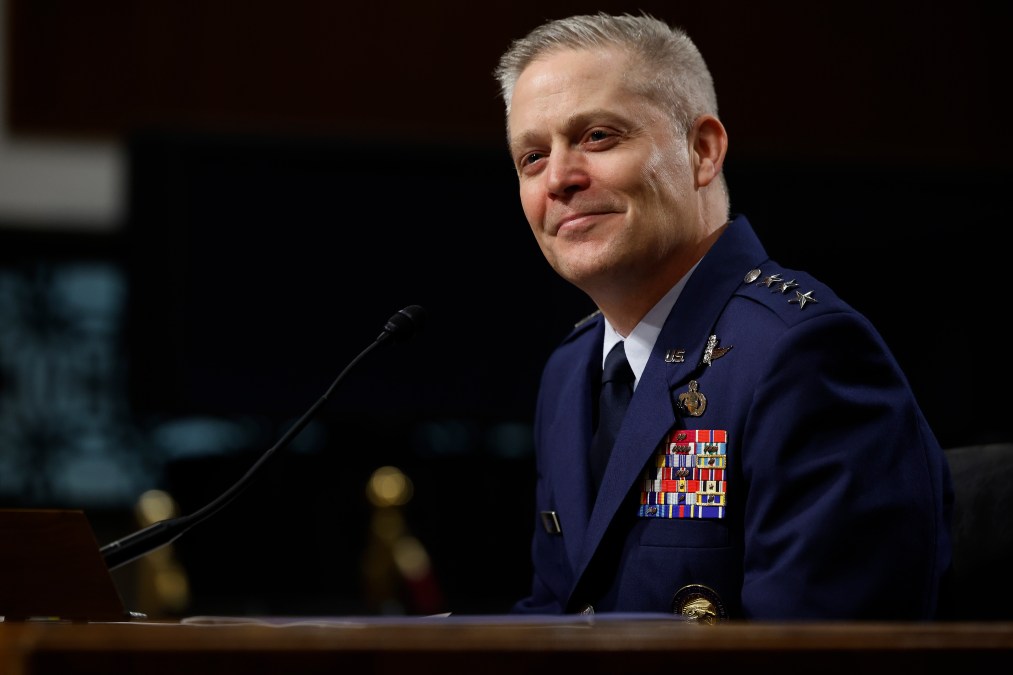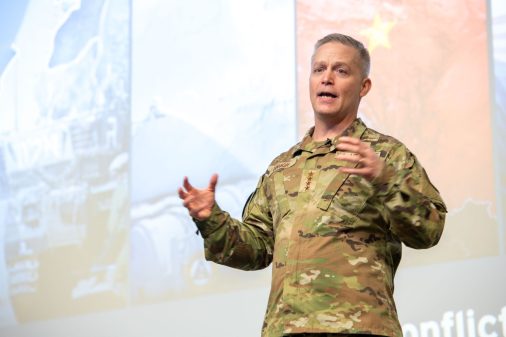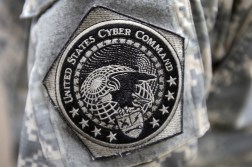A new era: Gen. Timothy Haugh takes over for Gen. Paul Nakasone at Cyber Command

FORT MEADE, Md. — Gen. Timothy Haugh assumed command of U.S. Cyber Command and the National Security Agency during a ceremony at Fort Meade on Friday, taking the reins from Gen. Paul Nakasone, who is retiring as the longest-serving Cybercom chief after six years in the job.
Haugh was most recently the deputy commander of Cybercom since August of 2022. He will be the first Air Force officer to helm the organization — the first three commanders came from the Army, Navy and Army — and the first Air Force officer to direct the NSA since the mid-2000s.
Some have noted the benefit of finally having an Air Force member in those positions and what that does for the service and its efforts to recruit and retain top cyber talent.
“I think for any member of the Air Force’s intelligence or cyber community to see one of their own as the new Commander is very motivational and proves that making it to the very pinnacle of leadership within the Department of Defense is possible,” Charles “Tuna” Moore, a retired Air Force three-star who served as the deputy commander of Cybercom, told DefenseScoop. “Tim is, without a doubt, the most qualified individual to take command of both organizations. Not just in terms of his pedigree and background in both the intelligence community and within U.S. Cyber Command, but also his success and his approach to leadership, team building and partnerships.”
Haugh has received high praise for a long time for his expertise in the cyber and information realms.
Haugh “probably knows more about competition in the cyber domain than anybody. He’s well known at the highest levels of government,” David Goldfein, the former chief of staff of the Air Force, said in 2019 at the stand-up of the Air Force’s first information warfare numbered Air Force, for which Haugh was the inaugural commander.
Vice Chairman of the Joint Chiefs of Staff Adm. Christopher Grady said during the change-of-command ceremony, held at the Morrison Center at Fort Meade, that Haugh is well prepared to accept the responsibly and there is no one more qualified. Similarly, Director of National Intelligence Avril Haines said he was “intellectually exceptional.”
Many sources noted the close working relationship between Haugh and Nakasone and their similar leadership styles, with some calling them “battle buddies.” And as a result, they expect a smooth transition. The two have worked together for years in various roles at the command and subordinate units, with Haugh traveling with Nakasone quite frequently the last few years even before he was the deputy at Cybercom.
Given the similarities, there likely won’t be any immediate changes once Haugh takes over, according to experts.
Haugh has stressed the importance of continued operations in the cyber domain as a means of meeting and beating back adversaries constantly — an endorsement of the command’s concept of persistent engagement, which encompasses challenging foes’ activities daily and wherever they operate.
“I think we need to engage our adversaries if they’re conducting activities that are malign and have a negative impact on the national security [of the] United States or a negative impact on our allies and partners,” he told the Senate Intelligence Committee in July as part of his confirmation process. “That ability to do that and the ability to put pressure on them, expose their activities, while also making our allies and partners more resilient, is absolutely critical every day so that they know that they’re contested.”
Experts have noted in the past that the persistent engagement concept was a response to a trend of inaction. Prior to 2018, before the Department of Defense was afforded more authorities to conduct operations in cyberspace, there was a bias for inaction and very few operations actually took place, seeding the domain to malign behavior, according to opponents of the old way of doing things.
According to Nakasone, persistent engagement was something the command got right and should continue into the future.
“I think we got persistent engagement completely right. Remember before 2018, we have a force that is really on the sidelines,” he told reporters at a roundtable at Fort Meade Tuesday. “If you’re on the sidelines watching this, you’re going to get hit. That’s why I think it’s so important for our forces worldwide to be able to be engaged, and being able to act and understand what our adversaries are doing … Being able to continue to operate day in and day out, this is how you get really good. You operate in the domain. This is what Special Operations Command has taught us, right? Continued operations build proficiency and professionalism. We’re going to need that. I think a lot about that piece, in terms of where Cyber Command is going.”
Nakasone also reflected on the changing nature of the domain and operations, as more players get involved and new technologies affect the space.
He described a timeline of progression where fears of a so-called cyber Pearl Harbor a decade ago have not materialized.
“I think we’re in the middle of this timeline where we’re going to increasingly see the capabilities of non-kinetic operations, whether it be cyber or [electronic warfare] or [information operations], take on increasing responsibility,” he told reporters, adding that it’s difficult to imagine non-kinetic capabilities supplanting kinetic ones in conflict. “Being able to secure your networks, data and weapon systems, I think, become even more important in the future.”
Moore surmised that information capabilities, and specifically cyber-enabled information ops, will grow in importance for the DOD and the nation.
“The vast majority of information operations now and going forward in the future are going to take place in the digital space. So, you have to have a single person who is responsible for synchronizing, integrating and deconficting all operations inside the cyber domain. In the U.S. Department of Defense that person has to be the commander of U.S. Cyber Command,” he said. “You have to have an overarching information operations strategy for your adversaries. It can’t be individual pickup games and pockets of excellence that are kind of deconflicted. To be effective, you must have a strategy that deals with all of your actions, operations and investments.”
In recent years, adversaries have sought to exploit the information environment through disinformation, misinformation, information operations and other activities as a means of undermining U.S. and allied interests without having to confront them in direct military conflict.
The DOD has sought to play catch-up of sorts, releasing updates to doctrine and strategy — and the services themselves issuing their own guidance within the information realm.
One thing Haugh likely won’t face is calls to sever the so-called dual-hat arrangement, one of the most hotly debated issues within the cyber world. Since Cybercom was created a decade ago, it has been co-located with NSA at Fort Meade, Maryland, and shared a leader. At the time, this made sense to help the nascent command grow, relying on the personnel, expertise and infrastructure of the NSA. The arrangement was initially expected to be temporary.
However, proponents of keeping that setup intact say the military can benefit from the unique intelligence insights and resources of NSA, leading to faster decision-making and operational outcomes. Opponents argue the roles are too powerful for one person to hold and relying on the intelligence community’s tools — which are meant to stay undetected — for military activities poses risks to espionage efforts.
According to a former military cyber official who spoke to DefenseScoop on condition of anonymity, the dual-hat question seems settled for now given Chairman of the Joint Chiefs of Staff Gen. Charles “CQ” Brown’s endorsement of it along with strong congressional endorsement of the arrangement.
Haugh has also advocated it remain intact.
Haugh said at the ceremony that as he looks toward the future, he’s mindful that there is clear guidance from the National Defense Strategy, the team understands the global threat environment, and the people and talent at the organization are unmatched. He added that there are three ways the organization will keep its advantages: people, technology and partnerships.
New authorities and a growing, changing force?
Sources and experts indicated that Haugh will get to take advantage of new authorities Nakasone fought to gain, but was not able to fully realize before he retired. These include increased service-like authorities similar to what Special Operations Command has regarding the ability to acquire capabilities and direct the services on manning and training requirements.
“We worked a long time to get additional authorities for the command, like enhanced budget control, and a component acquisition executive. I expect Tim will initially be very focused on the maturation and execution of those new authorities. Fully exercising them to the level that Gen. Nakasone just didn’t have the opportunity to do,” Moore said.
Cybercom was slated to gain enhanced budget control, granted by Congress, at the beginning of fiscal 2024, however a full budget has not been passed yet.
That authority provides direct control and management of planning, programming, budgeting and execution of the resources to maintain the cyber mission force. Haugh implored Congress during his confirmation process to pass a budget so the authorities will go into effect to allow the command to address readiness issues and move into its next era of growth and maturation.
“I see Gen. Haugh growing the force, institutionalizing and regularizing the processes and capabilities that were necessarily custom-built earlier in Cybercom’s development. The fuller exploitation of the Socom-like raise, train, and equip (RT&E) authorities recently conferred by Congress, and more fully exercising the operational authorities now in place, seem like two top priorities,” Tom Wingfield, a senior international and defense researcher in RAND’s Department of Defense and Political Sciences and the deputy assistant secretary of defense for cyber policy from 2019 to 2021, told DefenseScoop. “The larger questions of whether those RT&E authorities will be sufficient, or if there will be more pressure for a separate cyber service to handle the RT&E half of things, will become clearer during his tenure.”
Haugh will likely face continued calls in the coming year for the creation of an independent cyber service, akin to the Army, Navy, Marine Corps, Air Force and Space Force. Proponents of an independent cyber service argue that cyber operators have no distinct identity — as they are still members of their respective services — there are readiness issues associated with each service resourcing their cyber contributions differently, lexicon and pay scales are different, and the command-and-control structures are confusing. Moreover, they allege only an independent cyber force or service can solve key problems.
Cybercom and DOD are in the midst of reevaluating the future of the command, an effort dubbed Cybercom 2.0, in an attempt to update it for the next generation.
“There is also the open question about the size and composition of the force — Cybercom is still working with only an incremental increase over the conservative 2012 estimate of what would be needed to accomplish the mission. Most thoughtful observers believe we need a substantially larger force, but creating new billets, or carving them out of the services, would take sustained presidential and congressional support,” Wingfield said.
Given that the command and force were created and designed about a decade ago, based upon many principles of the day that are now outdated due to the fast paced nature of the domain, the review is taking a top-to-bottom look at how to best posture Cybercom for the future.
Haugh will be responsible for working with the cross-functional team, Congress, experts and the secretary of defense to push forward the command’s needs and the organization’s next iteration.
“Haugh is well versed with the challenges the services have faced with sustaining appropriate readiness for the Cyber Mission Force and he has played a key role in the CYBERCOM 2.0 effort,” a former military cyber official told DefenseScoop.
The former official cited Haugh’s past roles as deputy commander of Joint Task Force Ares, the command’s organization designed to fight violent extremist groups; Cybercom director of intelligence; commander of the Cyber National Mission Force, the command’s elite cyber warriors responsible for defending the nation from digital threats; commander of 16th Air Force, the service’s information warfare command; and Cybercom’s deputy commander. Haugh understands better than most what must happen to enable the command to scale to the constantly evolving threat, the former official said.
A look back
Nakasone is the longest-serving Cybercom commander, having been in the job since May 2018. While he was asked to stay on for an extra year in May 2022, his retirement and change of command was also held up due to the months-long blanket hold on senior military officer confirmations that Alabama Republican Sen. Tommy Tuberville imposed in protest of the DOD’s abortion policies.
Nakasone has been venerated by those in and out of government — receiving a standing ovation from the House Select Committee on the Chinese Communist Party during a hearing Jan. 31 — navigating tricky political waters and taking over at an inflection point in Cybercom’s history, as it was elevated to a full combatant command. He has also dealt with a changing national security landscape with the shift from counterterror operations to great power competition with nations such as China.
He was responsible for developing the command vision that outlined the concept of persistent engagement and sought for increased authorities to enable the command to acquire and manage necessary capabilities for digital warriors to conduct operations.
In a letter from President Joe Biden read during the ceremony, the commander-in-chief said he was profoundly grateful for Nakasone’s leadership during this dynamic time, adding that the military is better postured based on his vision.
Grady said Nakasone ushered in an important era for cyber, and Deputy Secretary of Defense Kathleen Hicks noted that he shaped the nation’s military strategy.
“I was thinking about the past several years and I wrote down several things. Russia Small Group, SolarWinds, Colonial Pipeline, Afghan Retrograde, Russia/Ukraine, high-altitude balloons, Israel/Hamas. Every single one of those our agency and command was in the center making a difference, ensuring the security of our nation, and saving lives. And that, I would tell you, I’m really proud of,” Nakasone told reporters this week.






